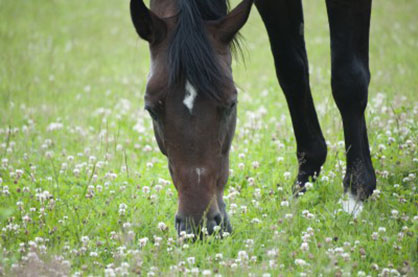Know What You Grow: Clover Toxicity and Horses
Michigan State University Extension
By: Taylor Fabus
While fresh summer pastures may provide your wallet some temporary relief with lower feed and hay bills, fall is quickly approaching. The cooler, wetter weather provides the perfect breeding ground for clover and, unknowingly, the fungi and toxins that may come with it.
The most typical fungus to infect clover is Rhizoctonia leguminicola. More commonly known as black patch for the bronze to black spots it creates on the stems and leaves, the fungus is likely to be found on either white or red clover. The clover plants themselves are non-toxic and it is the fungus that contains the toxin slaframine that causes the undesirable symptoms in horses.
Slaframine is known to stimulate the salivary glands of a horse and lead to an excessive amount of drooling, or “the slobbers.” While it is a nuisance and rather unpleasant, the condition is not life threatening. The toxin slaframine can be found in pasture or dried hay. Once identified, the fungus can be effectively destroyed by removing the horses from the infected pastures, mowing down the affected spots and using a pasture-friendly broad leaf herbicide to eliminate any any remaining broadleaf plants, such as clover.
Another clover likely to grow in your pastures as fall weather begins is alsike clover. Although similar-looking to other clovers, alsike clover can be identified by its flowers, which are dark pink at the base and light pink towards the tip. Unlike the relatively non-toxic red and white clovers, alsike clover is known to cause two more serious conditions in horses: photosensitization and big liver syndrome.
The toxin in alsike clover that causes these two severe conditions remains unidentified. Photosensitization occurs with short-term exposure and clinically appears to look like sunburn that becomes crusty, dies and may slough off entirely. Horses that remain inside for the day or are blanketed while outside may not show these more typical symptoms and, in these cases, photosensitization can present as oral lesions, diarrhea and even colic.
Long-term exposure to the alsike clover may lead to big liver syndrome, which is the progressive destruction of the liver. Symptoms of liver failure due to alsike clover consumption include loss of appetite, weight loss, depression, jaundice, colic and death. It goes without saying that if you observe any of these changes in your horse, contact a veterinarian immediately because liver failure is often fatal.
With fall weather comes changes in pasture vegetation and you should always be on the look out for significant clover growth. Pasture management plans should be reviewed annually, especially if you continue to notice a problem with toxic plant growth. The easiest way to prevent your horses from consuming toxic plants is to know what you grow and watch what your horses eat.
If you are unsure of a plant species, Michigan State University Extension suggests you bag it and use the following free guides, with pictures, to help you with identification:
- Identifying pasture grasses by University of Wisconsin Extension
- Identifying pasture legumes by University of Wisconsin Extension
This article was published by Michigan State University Extension. For more information, visit http://www.msue.msu.edu. To have a digest of information delivered straight to your email inbox, visit http://www.msue.msu.edu/newsletters. To contact an expert in your area, visit http://expert.msue.msu.edu, or call 888-MSUE4MI (888-678-3464).











